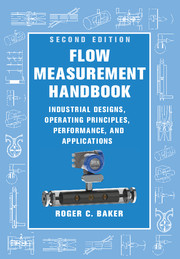Book contents
- Frontmatter
- Dedication
- Contents
- Preface
- Acknowledgements
- Nomenclature
- 1 Introduction
- 2 Fluid Mechanics Essentials
- 3 Specification, Selection and Audit
- 4 Calibration
- 5 Orifice Plate Meters
- 6 Venturi Meter and Standard Nozzles
- 7 Critical Flow Venturi Nozzle
- 8 Other Momentum-Sensing Meters
- 9 Positive Displacement Flowmeters
- 10 Turbine and Related Flowmeters
- 11 Vortex Shedding, Swirl and Fluidic Flowmeters
- 12 Electromagnetic Flowmeters
- 13 Magnetic Resonance Flowmeters
- 14 Ultrasonic Flowmeters
- 15 Acoustic and Sonar Flowmeters
- 16 Mass Flow Measurement Using Multiple Sensors for Single-Phase Flows
- 17 Multiphase Flowmeters 508
- 18 Thermal Flowmeters
- 19 Angular Momentum Devices
- 20 Coriolis Flowmeters
- 21 Probes for Local Velocity Measurement in Liquids and Gases
- 22 Verification and In Situ Methods for Checking Calibration
- 23 Remote Data Access Systems
- 24 Final Considerations
- References
- Main Index
- Flowmeter Index
- Flowmeter Application Index
21 - Probes for Local Velocity Measurement in Liquids and Gases
Published online by Cambridge University Press: 05 August 2016
- Frontmatter
- Dedication
- Contents
- Preface
- Acknowledgements
- Nomenclature
- 1 Introduction
- 2 Fluid Mechanics Essentials
- 3 Specification, Selection and Audit
- 4 Calibration
- 5 Orifice Plate Meters
- 6 Venturi Meter and Standard Nozzles
- 7 Critical Flow Venturi Nozzle
- 8 Other Momentum-Sensing Meters
- 9 Positive Displacement Flowmeters
- 10 Turbine and Related Flowmeters
- 11 Vortex Shedding, Swirl and Fluidic Flowmeters
- 12 Electromagnetic Flowmeters
- 13 Magnetic Resonance Flowmeters
- 14 Ultrasonic Flowmeters
- 15 Acoustic and Sonar Flowmeters
- 16 Mass Flow Measurement Using Multiple Sensors for Single-Phase Flows
- 17 Multiphase Flowmeters 508
- 18 Thermal Flowmeters
- 19 Angular Momentum Devices
- 20 Coriolis Flowmeters
- 21 Probes for Local Velocity Measurement in Liquids and Gases
- 22 Verification and In Situ Methods for Checking Calibration
- 23 Remote Data Access Systems
- 24 Final Considerations
- References
- Main Index
- Flowmeter Index
- Flowmeter Application Index
Summary
Introduction
We resort to probes for flow measurement for three main reasons:
i. To provide a low-cost method of flow monitoring;
ii. To provide an in situ calibration;
iii. To obtain fine detail of the flow in the pipe (velocity profile, swirl and turbulence).
For our present purposes, we shall not consider (iii). It is relevant to fluid mechanics research, mainly uses hot-wire and laser Doppler anemometers, and is, therefore, outside the scope of this book. We will concentrate on work relating to bulk flow measurement. In situ calibration techniques are covered in Chapter 4. In this chapter, we shall consider the various devices that have been used and are, or have been, commercially available either as a local flow monitor or as the probe for in situ calibration. However, before considering these, we need to understand what is being measured.
i. Ideally, the probe measures the local velocity and obtains a representative value of the mean velocity from the shape of the velocity profile. Alternatively, it may measure the complete profile.
ii. In practice, the probe may be in error because:
• it was calibrated in an approximately uniform profile or on the pipe axis but will need to measure velocity profiles that result in a significant variation of velocity across the sensing head;
• it will alter the flow by its presence, may shed vortices and may oscillate as a result; and
• the flow pattern will continue to change as the probe head is inserted further and further into the pipe and as it approaches the opposite side of the pipe.
In some cases, these flows may be analysed theoretically, but in most cases one would expect to calibrate the probe, and this calibration will be different at the pipe axis and at the pipe wall.
iii. The probe will reduce the flow area of the duct by its presence, and the area will continually decrease as the probe is inserted further. This blockage will need to be allowed for. The blockage will also differ between incompressible and compressible fluids.
Our object in using a probe is to obtain the best measure of the local flow rate that can be obtained. We shall need to remember both the limitations of the probe and the uncertainty of the relationship between the reading and the mean velocity.
- Type
- Chapter
- Information
- Flow Measurement HandbookIndustrial Designs, Operating Principles, Performance, and Applications, pp. 603 - 616Publisher: Cambridge University PressPrint publication year: 2016



